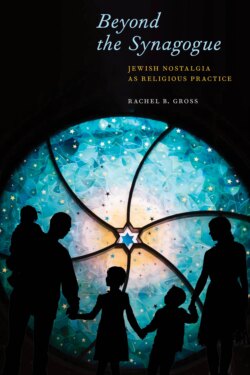Читать книгу Beyond the Synagogue - Rachel B. Gross - Страница 9
На сайте Литреса книга снята с продажи.
Introduction Feeling Jewish
ОглавлениеThe visitors to the Museum at Eldridge Street sat in the pews of the restored 1887 Eldridge Street Synagogue. Looking upward, they admired the elaborate Moorish-style interior. A docent described Eastern European Jewish immigrants’ lives and aspirations at the turn of the century, when they worshipped in the grand synagogue. The Eldridge Street Synagogue was the first synagogue building the immigrants constructed in the crowded Lower East Side neighborhood. But, over the years, the congregation dwindled and the building decayed. The cavernous sanctuary was shut up for four decades. Finally, after two decades of effort, preservationists restored it to its former glory. When the docent finished her story, she started to lead the group out of the sanctuary.
On her way out, the docent paused at the back of the room. She instructed her group to assemble in an open space where the Museum had removed pews. “Step into the indentations in the floorboards,” she told them. Soon, people had arranged themselves into straight lines. Pointing to the pattern of indentations, she asked, “Why do you think these are here?” Slowly, the group realized that they stood in footprints of former male congregants. The indentations had been made by men shuckling, rocking back and forth in front of their pew as they prayed in a traditional Jewish fashion. Over the years, they had left their mark in the soft pine floorboards. The docent demonstrated the movement, and others copied her. A few tourists were familiar with the rocking motion from their own synagogue services. Most shuffled more awkwardly, if enthusiastically.1
Standing in the footprints of former congregants provides an immediate, sensory connection to the past, one that engages visitors’ entire bodies. The experience is a highlight for many tourists. As one wrote on Yelp, “You literally feel the history at your feet.”2 Roberta Berken, who has served as a docent at the Museum at Eldridge Street for over a decade, relates as she shows people the floorboards:
Figure I.1. Eldridge Street Synagogue exterior, New York. Photo by Viktor Korchenov, 2006. Licensed under CC BY-SA 3.0.
Perhaps the boots which made these grooves came from Minsk or from the shoe store on Essex Street. A prosperous man may have had new shoes. On the way to shul [synagogue] he may have stopped to have his shoes shined by Max the shoe shine boy, there with his shine box. A working man would have walked with his oft-mended shoes on his way to shul. Both walked through the snow in winter and the hot pavements in summer. The words and rhythm of Yiddish filled the [streets]. The Yiddish signs announced “Fresh fish!” “Fresh baked challah!” or “Pumpernickel and 3 pounds of potatoes for a penny.”3
Berken fills in her story with imaginative details about the lives of early congregants. She uses the floorboards to help visitors picture a lost world of the early twentieth-century immigrant neighborhood and develop an emotional relationship to it.
Tourists did not just happen to arrive at this synagogue and place their feet in the grooves of long-ago congregants. The Lower East Side has long been seen as an authentic site of emotional connection to American Jewish pasts. American Jewish immigrants began to move their families out of the crowded neighborhood for more spacious parts of the city and suburbs in the early to mid-twentieth century. Still, they kept thinking about the neighborhood, and some kept coming back. In the early twentieth century, those Jews who left the Lower East Side were replaced by new arrivals, until Congress severely limited immigration in 1924. Beginning in the 1970s and 1980s, as a white ethnic revival developed and many Americans turned their attention to their ancestries, American Jews thought about their former urban ethnic neighborhoods with nostalgic longing.
As part of this movement to feel a connection to the places where their ancestors had lived, worked, and prayed, the Eldridge Street Project began to raise money to restore and preserve the Eldridge Street Synagogue in 1986, and the building formally opened to the public as the Museum at Eldridge Street in 2007. Preservationists made careful and strategic choices about the building’s restoration, such as leaving intact the worn pine floorboards in order to foster a sense of physical connection with earlier generations. This book argues that the tourist activity of visiting the Museum at Eldridge Street—and the nostalgia it both inspires and is inspired by—should be understood as an American Jewish religious practice. Indeed, this book makes the case that American Jews participate in a broad array of ostensibly nonreligious activities—including visiting Jewish historic sites, conducting genealogical research, purchasing books and toys that teach Jewish nostalgia to children, and seeking out traditional Jewish foods—that are properly understood as religious. Understanding these practices as religious ones illuminates the ways many American Jews are finding and making meaning within American Judaism today.
